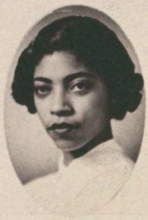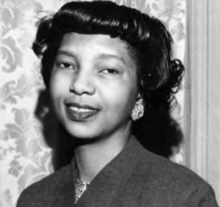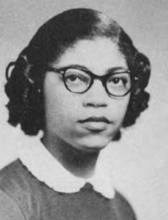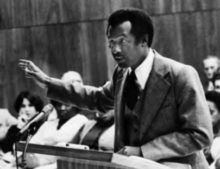During Black History Month, the Law School is recognizing the central role of impactful Black figures in our past, present, and future, highlighting their achievements and celebrating their successes.
One such pioneering figure is Gloria Bradford ’54—a contemporary of Heman Sweatt and Virgil Lott—the first African American woman to graduate from Texas Law, the first to try a case in Harris County District Court, and a barrier-breaker throughout her life. Ms. Bradford was the subject of a recent, glowing feature written by Jasmine S. Wynton for the Texas Supreme Court’s Historical Society. We are honored to be able to share Ms. Wynton’s work, with permission, below.
We encourage readers to visit the original version of this article to view footnotes containing historical context and valuable references which, because of formatting restrictions, we were unable to include here.
A PROFILE IN COURAGE: GLORIA KATRINA BRADFORD
By Jasmine S. Wynton
Originally published in the Journal of the Texas Supreme Court Historical Society’s Fall 2020 edition.
Gloria Bradford in her
1954 Senior Law Composite. Courtesy of the Tarlton Law Library, The University of Texas at Austin.Before the U.S. Supreme Court’s 1954 landmark decision in Brown v. Board of Education, which History has paid much attention to Mr. Sweatt for paving the way for other African Americans to receive a legal education in Texas, and to his classmate, Mr. Lott, who ultimately became the first African American to graduate from the University of Texas Law School. Less known is the story of Gloria Bradford, a courageous young woman who would later enroll at UT Law School in fall of 1951—just a year after Mr. Sweatt’s historic victory—and in 1954, become the first African American woman to graduate from the law school. This article seeks to shed a much-deserved spotlight on the story of Ms. Bradford, an African American woman who dared to enroll in law school in the Jim Crow South, in an era in which women were being denied the most basic rights on the basis of their sex, such as the right to serve on a jury. Despite facing double discrimination based on race and gender, Ms. Bradford successfully graduated from UT in 1954, earned a Texas law license, and went on to become the first African American woman to try a case in Harris County District Court.
Early Life
Gloria Katrina Bradford was born on February 19, 1930, to James K. Bradford and Olivia Sweeney Bradford. She was the oldest of three girls. She grew up mostly in Houston, Texas, but briefly lived in Massachusetts for two years, where she went to school for seventh and eighth grades in Cambridge, before returning back to Houston. Her father was a doorman at what was then known as Rice Hotel in downtown Houston, Texas. Her parents divorced when she was 12 and her father obtained custody over Gloria and her sisters, and she lived with her father’s mother throughout high school. She attended public, segregated schools in Houston. Her first exposure to attending an integrated school, however, was when she attended middle school at Henry Wadsworth Longfellow school in Cambridge, Massachusetts. Bradford would later recall that she enjoyed attending an integrated school in Cambridge, and felt that she was treated like an equal, despite being one of perhaps twenty black students out of 800 total students. Further, it was at school in Cambridge that she was first exposed to the arts and music, where students would have the opportunity to win tickets to the symphony. Bradford would later return to Houston for high school. In 1946, she graduated from Booker T. Washington High School, which, at the time was located at its original location on West Dallas Street in downtown Houston.
Pre-Law School
Bradford graduated from Prairie View A&M College (now Prairie View A&M University) in 1949, while it was also segregated. Initially, Bradford was a chemistry major at Prairie View, but then later changed her major to political science and history. Bradford was interested in current events and public affairs, which she attributes to her paternal grandmother, an elementary school teacher, who instructed Bradford and her sisters to better themselves by being aware of current events and staying engaged. Even though she was interested in political science, Bradford had not seriously considered going to law school while she was in college.
As an undergraduate student at Prairie View, Bradford was involved in the student Christian movement during college, particularly the Young Women’s Christian Association (YWCA), and the Young Men’s Christian Association (YMCA). Indeed, during her senior year, Bradford served as the fourth vice president of the national YWCA, which would have her travel to places from the Hill Country to Wisconsin with students from across the nation—an experience that Bradford would later describe as her “first formative experience with integrated settings in school.” Furthermore, Bradford was also involved in photography as a college student, describing herself as a photographer and as one that was “always out in the lime-light.”
After graduating from Prairie View, Bradford moved to Washington, D.C., where she interned during the summer of 1949 for the Library of Congress. Following her internship with the Library of Congress, Bradford worked briefly as a saleswoman for a plastics company called the House of Plastics before working as a cash accounting clerk for the Department of Treasury Bureau of the Public Debt in 1950. That same year, Bradford also began post-graduate work at American University. She also served as a member of the Friends Committee on National Legislation.
It was during her time working in Washington that Bradford would be inspired to attend law school by her roommate at the time, Charlye O. Farris, a law student at Howard University law school. Farris, a fellow Texan and a former classmate of Bradford’s, also graduated from Booker T. Washington High School and Prairie View with a degree in Political Science. It is telling that Bradford and Farris were roommates, as Farris would later become the first African American woman to be admitted to practice law in Texas in 1953, and the first African American to serve as a judge in any capacity in the South since Reconstruction.
Charlye O. Farris. Courtesy of the State Bar of Texas Archives
In law school, Farris would have her Howard Law classmates over to their apartment for law school bull sessions. Bradford participated in these sessions with Farris and her classmates. Because Bradford often knew the answers to their questions, especially those regarding bills and notes (due to her Treasury Department experience), they encouraged her to go
to law school. Shortly thereafter, just a year after the Sweatt decision, 21-year-old Bradford applied to UT law school. She chose UT because she continued to maintain her Texas residency, even paying a poll tax of $1.50, which entitled her to vote in Texas. Initially, the administration at UT Law questioned Bradford’s residency, arguing that she was a Mississippi resident because her mother lived there, but she overcame it with proof that she had always been in the custody of her father, who lived in Texas, until his death, and that since his death she had bought a poll tax and was a registered voter in Texas.Law School
UT Law finally admitted Bradford, and she moved to Austin to begin law school in 1951. Bradford felt she already had “some rapport” at UT before she arrived because she was friends with Block Smith, who had been the executive secretary of the UT chapter of the YMCA. Heman Sweatt was repeating his first year at the time she began. There were several other black students enrolled at the time including George Washington, Jr., Virgil Lott (who would become the first African American to graduate from the school), Ollis Malloy, and another woman name Vivian Brooks, who would later drop out of school after the first year. There was no formal or informal association of Black students, law or otherwise, while Bradford attended UT Law. But Bradford noted that she was familiar with some of the first African Americans to be admitted to the University as a whole, and would see them in the cafeteria and other similar places, and would catch rides home with them, among other things.
Bradford was impressed with the law school and enjoyed it, describing it as a “tough program” where “they didn’t take any nonsense.” She did not know how highly ranked the program was until she actually enrolled in the law school. She learned by word of mouth which professors to avoid, including those professors that would be harder on her because she was a woman or because she was African American, and she was able to avoid taking classes with those professors. Property was one of Bradford’s favorite classes, which she took with Professor Gus Hodges, and she performed well in that class.
Bradford believed that the professors graded her harder than her non-black counterparts, which ensured that she, along with the African American students were excluded from the law school fraternity Phi Alpha Delta. Bradford, like other African American students, was excluded from fraternities and sororities, and there were no African American fraternities at the time. Nonetheless, according to Bradford, the white and Hispanic students at UT law treated her well. There was a “camaraderie” which “went past the segregation problem.” In contrast, Bradford’s predecessors might not have quite said the same. Indeed, upon leaving the library late one night, Sweatt found a large crowd brandishing a burning cross waiting across the street from his parked vehicle, whose tires were slashed.
During law school, Bradford met Thurgood Marshall, who was attending a state convention in Austin. Sweatt had dropped out of the law school program due to health issues, but Marshall told Bradford, “You’re going to make it.” Bradford said that this was encouraging. Bradford said that this was the first time she met Justice Marshall and that he had nothing to do with getting her to apply to law school.
Bradford was nominated for the fifth Portia of the law school in 1953. The Portia was the “private sweetheart” of the law school—it was essentially a beauty and popularity contest like the University Sweetheart at the undergraduate level. The qualifications included justice, virtue, beauty, and brains. To be nominated, a female student required 20 signatures. Nominated along with Bradford was Edna Cisneros, who would later become the first female Hispanic lawyer and district attorney in Texas. One of Bradford’s classmates, Gordon R. Pate, an attorney based in Beaumont, Texas, recalls Bradford, who was perhaps one of less than ten women in the law school at the time, as being “neatly dressed and quiet,” but confident.
While attending law school, Bradford spent most of the spare time she had shining shoes at a pool hall in East Austin. Bradford recalled that it was at that pool hall where she learned how to play pool. Housing in Austin at the time was still segregated, so she lived in the black neighborhood in East Austin. Her roommates attended Huston-Tillotson University. Despite the challenges of segregation, Bradford enjoyed her time in Austin. Bradford was the only Black member of the Young Democrats in Austin.
Legal Career
Gloria Bradford in the 1954 Peregrinus, the yearbook of the University of Texas School of Law. Courtesy of the Tarlton Law Library, The University of Texas at Austin.
Bradford graduated from UT law in May 1954, becoming the first African American woman to graduate from the law school. She passed the Texas bar exam that same summer, with a passing score of 77 out of 80. She was one of 138 new Texas lawyers (45 from UT Law). Bradford practiced general civil and criminal law in Houston at the now- defunct firm of Dent, Ford, King & Witcliff, which was made up of Black attorneys. After practicing with Dent, Ford, King & Witcliff, Bradford and two other attorneys opened up their own firm. Bradford was a member of the American Southwest Regional Bar Association, State Bar of Texas, Houston Lawyers Association, and the Houston Association for Better Schools.
Major Cases
Unsurprisingly, Bradford garnered attention from the press during the early years of her legal career. Sometimes she was the subject of the article featured in a local newspaper, because she was the first of her kind—a Negro woman attorney—to appear in courthouses in those towns. Other times, the focus of the article was on the high-profile case that she was working on at the time, but even so, her status as a Negro woman attorney and graduate of UT Law were discussed.
Bradford did not shy away from working on controversial cases. Indeed, in September 1954, less than two months after earning her law license, she appeared in federal court, seeking a temporary restraining order (“TRO”) against her alma mater, on behalf of John Winfred Walker, an African American seeking admission into the undergraduate program at the University of Texas. Walker was initially accepted to the University, becoming the first Black undergraduate student to be admitted to the school following the Supreme Court’s Brown ruling issued earlier that year in May. On September 2, however, shortly before Walker was to start classes, the University notified Walker and several other black students who were also admitted, that it had “canceled” their undergraduate admissions.
John W. Walker, circa 1970s. Courtesy of the Arkansas State Archives.
According to officials at the University, admitting Walker to the school would violate a policy set by the Board of Regents following the Sweatt decision, and the University did not offer blacks undergraduate courses that were not available at Prairie View and Texas Southern. Thus, despite being one of the first state schools in the south to accept blacks as graduate students, UT “continued to hold the line against allowing Negroes in undergraduate classes.”
Appearing before Judge Ben H. Rice, Jr. in the U.S. District Court for the Western District of Texas, Bradford argued in support of Walker’s request for a TRO against the University. Bradford argued that the Supreme Court’s decisions in Sweatt and its companion case, McLaurin v. Oklahoma State Regents, 339 U.S. 637 (1950), were controlling and under the doctrine established by those cases, Walker should be admitted to UT. According to news accounts, Bradford “outlined in detail differences in first-year engineering curricula at the University and at Prairie View,” explaining “[s] ince Prairie View does not even offer a course in petroleum engineering (Walker’s chosen field of study), it would be presumptious [sic] to say that he will derive equal benefits by attending that school.” The University’s counsel argued that the issuance of a TRO would only maintain the status quo of Walker’s status as a non-student, and that cases like Walker’s should be deferred until the Supreme Court decided how to implement its ruling in Brown. According to the University’s counsel, admitting Negro students would create new and unique problems for the school and that long-term planning was required before Negroes and whites could be integrated at UT. Bradford responded that since Negro students were already enrolled at the University, admitting Walker would not create any new problems.
Judge Rice denied the request for a TRO without providing a reason and the case did not progress. Walker went on to become a prominent civil rights attorney. He attended Arkansas A&M College, earned a master’s degree at NYU, and graduated from Yale Law. He was the third intern of the NAACP Legal Defense Fund before opening a civil rights litigation firm in Little Rock, often partnering with the NAACP LDF.
In October 1954, Bradford made headlines when she was appointed to represent a black man who wanted to plead guilty to a theft charge and became the first black woman attorney to try a case in the Harris County criminal district court. Several years later in July 1957, Bradford made headlines again when she represented Southern Standard Life, an insurance firm in a contempt of court hearing in the 98th District Court in Travis County. Indeed, the Austin Statesman newspaper ran an article titled, “Negro Woman Attorney Appears in Court Here,” regarding Bradford’s appearance in the case. Bradford—described as a “tall, soft-spoken graduate of the University of Texas Law School,”—was the first African American woman lawyer that then-Deputy District Clerk George Bickler reported seeing in his 37 years at the courthouse.
One of the more notable cases in which Bradford would appear was the appeal of a lawsuit in which the State of Texas sought to permanently bar the National Association for the Advancement of Colored People (NAACP) from operating in Texas. In 1956, the Texas Attorney General John Ben Shepperd, seeking to handicap the NAACP, accused the New York nonprofit organization of practicing law in Texas without a license, committing barratry (illegal solicitation of potential clients for the purpose of harassment or profit) and champerty (illegal financing of litigation by third party that had no prior interest in the litigation in exchange for consideration contingent on the outcome of the litigation), and engaging in political activity. The lawsuits that the State questioned, were almost all filed against institutions of higher education or school districts for violations of integration rulings. Judge Otis T. Dunagan of the Seventh Judicial District Court of Smith County, Texas, granted the State’s request for a temporary restraining order (TRO) and a permanent injunction, preventing the NAACP from soliciting and financing lawsuits in which it had no direct interest and from engaging in political activities in Texas. The NAACP, however, was allowed to continue operating in Texas if it restricted its activities solely to charitable and educational functions. The NAACP appealed the permanent injunction. According to news reports, the NAACP initially had difficulty finding a Texas attorney to represent it in the appeal after its two Dallas attorneys, C.B. Bunkley and W.J. Durham, withdrew from the case. NAACP lawyers Thurgood Marshall and Robert L. Carter requested an 30-day extension of time to file exceptions to Judge Dunagan’s ruling as it continued its search for an attorney. Bradford made headlines shortly thereafter when she informed Judge Dunagan she would be representing the NAACP in the appeal of his injunction.
Bradford worked on the case for about three months, before the appeal was ultimately dismissed. Bradford would later explain that she concurred in the regional counsel’s decision that the injunction should not be appealed, and the appeal was later dismissed. This would be the only time that she would work with Justice Marshall or the NAACP.
After 6 years in private practice, Bradford moved to New York to work as a sales representative for Law Research, Inc., the first computerized research firm in the country. Later, she moved to northern California, to work as a sales manager for Encyclopaedia Americana in the military division for about 15 years before retiring. Bradford died in Oakland, California on January 20, 2013, leaving behind her two sisters, nieces and her cousin.
Legacy
In 2004, UT Law created the Society Program, which seeks to foster a sense of community among law students by breaking them out into smaller groups called “societies,” each of which contains a faculty advisor, a student program coordinator, and two student mentors to help advise and get students acclimated to the law school community. Each law student is assigned to one of eight societies in their first year and remain in the same society throughout the remainder of time at the law school. Each society is named after an individual that made a significant impact on the law school. Recognizing the significant legacy of Gloria Bradford, the law school named one of its eight societies in her honor.
There is still so much that we do not know about Bradford. What we do know, however, is that she clearly belonged to a legacy of courageous black students and attorneys that paved the way for African American men and women to attend institutions of higher education and practice law in the State of Texas. Following in the footsteps of Heman Sweatt, Virgil Lott, Charlye Farris, and others, Bradford broke both the color and gender barriers in the legal profession, blazing a trail for African American women attorneys like me to follow. It is not simply African Americans that have benefitted from her courage and efforts—all Americans have. Texas, like the rest of the country, has been blessed by its rich diversity. We owe a debt of gratitude to remarkable but perhaps underappreciated trailblazers like Bradford, who challenged America to live up to the highest of its founding ideals, that “all men are created equal.”
Click here to read the original story.




